|
Although Yellow-billed Loon (Gavia
adamsii) is an extremely rare visitor to Eastern and Central
North America, several recent records from the Great Lakes region
suggest that a tiny wintering population may exist. The first
unambiguous New York state record involves a first-winter bird
that frequented Oswego harbor from 21st December 1997 to at least
the 6th January 1998 (Phillips, 1998). There is one prior record
- a severely decomposed carcass found on a beach in eastern Long
Island sometime in the early 1930's (Zimmer, 1947), of which
only the lower mandible has been preserved [AMNH# 4005]. As there
is no positive evidence that the Long Island bird was alive when
it entered New York waters, it seems inappropriate, in my view,
to consider it the first acceptable record of a rarity of this
magnitude.
During January 1999, an adult basic Yellow-billed Loon was discovered
in the spill-way (West Canada Creek) leading from Hinckley Reservoir
on the border of Oneida and Herkimier Counties north of Utica,
NY. The confined location and continued presence of the bird has
allowed many area birders to get unique views of this exciting
visitor from the extreme High-Arctic.
Here are a series of photographs of the Hinckley Dam bird taken
on Saturday 23rd January 1999. The bird was feeding along the river
and was perhaps 100m from the road. Because of heavy pedestrian
traffic it avoided the area of the bridge from which other have
obtained increadibly close looks. During our visit, the bird kept
to the edge of the ice, presumably finding fish close to the banks.
We saw it catch and swallow a 6-7 inch long piklet and later another
unidentified fish. It was very attentive to the noise from excited
birders and suprisingly heavy road traffic.
All images are copyright © of Angus Wilson.
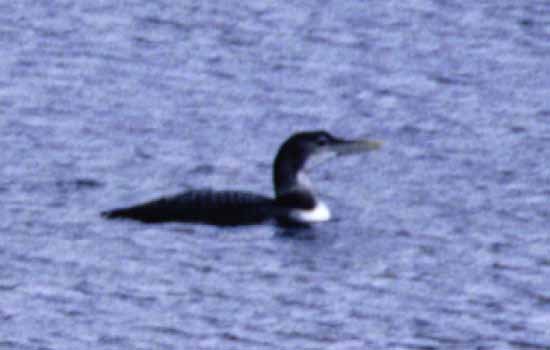
Figure 1. Side-profile
showing yellow bill, strong neck patterning and indistinct checkering
on mantle. This individual is somewhat atypical in the sharpness
of the division between dark hindneck and white foreneck. The ear
coverts are dark. The head and neck seemed as dark as the mantle.
In most Common Loons (G. immer), the head and neck look
darker than the mantle. Finally there was a distinct pale stripe
separating the dark hindneck from the broad neck collar.
|
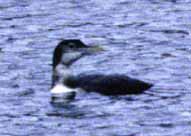 
Figure 2. View
of the front of the neck showing incomplete collar, 'chinstrap'
and slightly peeked forehead. Although the majority of the
bill was yellow (bordering on ivory at the tip) there was
a distinct bluish cast to the base of the bill.
|
|
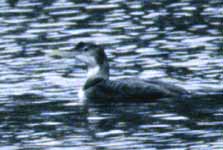 
Figure 3. Another
side view. Notice characteristic knob on forecrown, and weak
checker pattern on mantle (pale fringes on the scapulars
and mantle feathering).
|
|
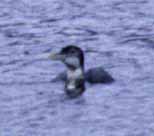 
Figure 4. Head-on view.
Body partially submerged. The breadth of this bird is visible
here. I was reminded of some great battleship.
|
|
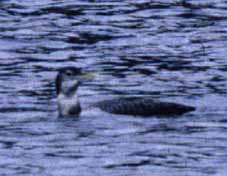 
Figure 5. Another side
view and again body partially submerged. The dark red eye
was offset by pale 'eyebrows'.
|
|
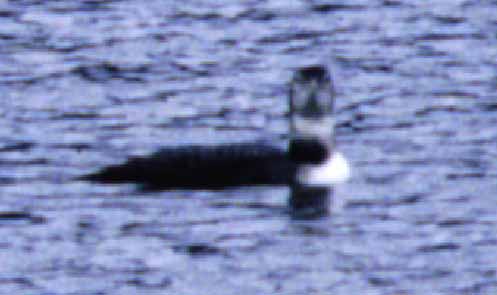
Figure 6. Slightly
out of focus picture but shows the foreneck pattern.
|
|
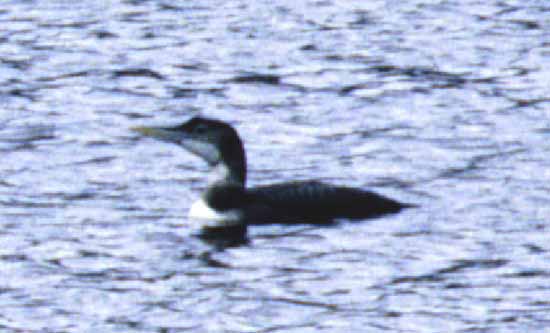
Figure 7.Side
view showing the 'chinstrap' and weak checkering on mantle.
Notice the straight edge to the upper mandible and distinct
curve (gonydeal angle) to the lower mandible. The bill is
held slightly above the horizontal in this picture but otherwise
was generally held much like Common Loon (G. immer)..
|
References:
Mark Beaman and Steve Madge (1998) The Handbook of Bird Identification:
for Europe and the Western Palearctic. Princeton University Press.
Gerard Phillips (1998) Yellow-billed Loon in Oswego Harbor: second
state record. First live sighting! The Kingbird 48(2): 98-102.
Zimmer, J.T. (1947) Yellow-billed Loon on Long Island, New York.
Auk 64: 145-146.
Return
to Gallery Index
|

